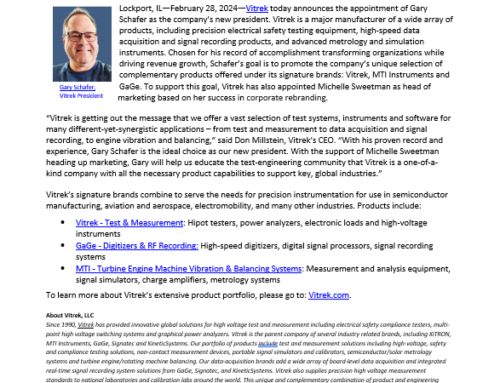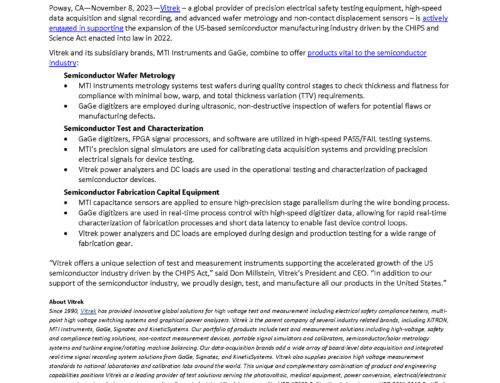
Why Capacitance?
Benefits and Applications of Digital Capacitive Solutions
Benefits and Applications of Digital Capacitive Solutions
By Don Welch, Director of New Business Development, MTI Instruments
Introduction
Industry applications illustrate the versatility and benefits of today’s digital capacitive sensor technology. The electrical capacitance formed between a capacitance probe and target surface varies as a function of the distance, or gap, between those two surfaces.
Parallel plate capacitive sensors have been solving measurement problems for a long time and their advantages, compared to other sensing systems, are well known. No physical contact between the sensor and target, for example, means zero mechanical loading, no probe or target wear, and no target distortion. Stability, precision and resolution, further more, match or exceed the capabilities of laser interferometers – at roughly one-third the cost.
Capacitive probes work in the harsh environments other sensors can’t touch. They can withstand temperatures as high as 1,200 F (650 C) as well as cryogenic temperatures (4 Degrees K). They will function in very strong magnetic fields (2 Tesla) or vacuum (10-7 Torr). Their record of service extends from the deepest depths of the oceans to the outer reaches of space.
Impressive as these measurement credentials are, new digital capacitance technology from MTI Instruments offers even greater capability. Consider these key features of the company’s Accumeasure™ D Series amplifiers:
- 24 bit resolution. Precision far exceeds that of commonly used 16 bit A/D converters – without the usual noise and/or non-linearity errors.
- No drift. Built-in digitally selectable filters optimize resolution and frequency response without adding extra offset and drift.
- Digital range extension. Users can sense distances not possible with analog amplifiers. Multiple range extensions can be added at time of ordering; as many as 10 are possible.
- Superior linearity and accuracy. Digital Accumeasure amplifiers digitally correct their linearity at every point in the range, not just at a couple of points on the displacement curve. Linearity specifications of 0.01% full scale range are typical.
- Compatible with the “Internet of Things.” Because Accumeasure D Series amplifiers embrace the new IoT with Ethernet and USB outputs, customers can network multiple sensors for embedded or web based applications and even display results on a smart phone.
In this paper, readers will discover digital capacitive displacement measurement solutions not possible with conventional analog systems. The following applications address a wide range of industry sectors. Each example demonstrates how digital capacitive sensing systems rival the performance of more expensive and complex measurement systems at a fraction of the cost.
Consumer Electronics: Fast Motion Control, Sub-Micron Accuracy
21st century electronic manufacturing requires fast, precise positioning of miniature components. For many assembly lines, process control has moved from mm to micron, or even sub-micron, accuracy. Keeping pace with the demand for greater precision requires piezoelectric positioning actuators and/or voice coil motors with closed-loop feedback control.
Challenge: Traditionally, analog feedback from capacitance sensors has enabled the closed-loop control of conventional positioning stages. Harnessing the extreme positioning accuracies achievable with voice coil motors or piezoelectric stages, however, requires motion stage feedback from a position sensor. Compared to analog systems, digital closed loop control offers more stability with less noise, interference, and/or distortion.

MTI digital capacitance amplifier with MTI ASP-500M-ILA capacitance probe, embedded in the Piezo System Jena PX-100 stage. The digital amplifier offers exceptional accuracy and linearity. Off-the-shelf control programs make it easy to use and tune digital feedback.
Solution: Recently developed digital capacitance sensor systems provide closed-loop feedback for precision positioning applications involving piezoelectric actuators or voice coil motors. These sensor systems comprise a digital capacitance probe and digital Accumeasure capacitance amplifier.
During operation, the probe measures piezo stage position in real time. The Digital Accumeasure Amplifier then sends the stage position to the programmable motion controller via Ethernet output.
The motion controller compares these feedback signals to a command position set point, enabling the controller to adjust the piezo stage with sub-micron precision. If a change in set point is commanded, or a process disturbance occurs, the controller performs calculations based on the changes and returns a value that puts the motion stage exactly where it is commanded to be. Overall performance depends on how fast the controller responds in conjunction with all of the positioning components and the feedback sensor.
Digital Benefits
- Built in superior 24 bit digital output eliminates the need for a separate A/D system
- Accommodates commercial off-the-shelf closed-loop servo software
- Digitally adjustable filter for best loop response / highest resolution
- Very low linearity error for highest precision in absolute positioning
- Multiple probes can be networked with no signal degradation
- Ethernet output for remote locations of sensors
Semiconductor Manufacturing: 3D IC Construction
To boost device performance, today’s semiconductor and microelectronics manufacturers are building three-dimensional integrated circuits featuring vertically-stacked silicon wafers and dies. The rationale is simple. Exploiting the Z axis avoids the latency and footprint penalties associated with two dimensional processes. Implementing the rationale, however, is not so simple. Going vertical requires coplanar surfaces to make contact with all pins, pads, and pillars.
Challenge: Typically, manufacturers measure the gap between two planes to determine coplanarity. Bonding tool actuators rely on these angle/gap measurements to adjust components and make sure all device pins and/or solder balls reside on the same geometric plane so they mate or bond together properly, without residual stress. This process is dubbed “active parallelism compensation.”
Because bonding success depends on the precision with which angle and gap measurements are made, active parallelism compensation can prove challenging and costly – especially when required resolution is in the sub-micron range.
Solution: To achieve high-resolution position control, MTI employs ASP-50-ILA capacitive displacement probes, a D-300 Digital Accumeasure capacitive amplifier, and actuator/control system. These components work together to monitor and adjust the gap/angle between the bond plane (die bonding tool) and ground plane (die or substrate).

Three gap measuring probes mount to the upper plane (die bonding tool). A control system monitors coplanarity of the tool to the lower plane (die or substrate) and provides position control to the actuators.
Setup involves mounting the probes to the die bonding tool; a minimum of three capacitance probes are needed to establish the planar surface. Likewise, a minimum of three actuators are required to adjust the die or substrate for coplanarity with the die bonding tool.
Gap measurements are processed by a D-300 Digital Accumeasure capacitive amplifier. The amplifier interfaces with the control system via 1000 base Ethernet or USB to monitor coplanarity and provide position control to the actuators. The amplifier and control system generate a 1,000 points/sec sample rate of the planar position.
Digital Benefits
- Built in superior 24 bit digital output eliminates the need for a separate A/D system
- Accommodates commercial off-the-shelf closed-loop servo software
- Digitally adjustable filter for best loop response / highest resolution
- Very low linearity error for highest precision in absolute positioning
- Amplifier linearity is 0.01% of full scale range
- Resolution is 5 nm p-p at 100 Hz loop position bandwidth speeds
- Less than 100 PPM drift
Power Generation: Wind Turbine Gap Monitor
Wind turbine production has been steadily increasing to meet growing demand for renewable energy. As power outputs and the number of installations climb, maintenance becomes ever more critical. Operators want to minimize downtime and protect against catastrophic failure. The ability to predict when maintenance will be required can go a long way to ensure these goals are met.
Challenge: A leading manufacturer of wind turbine power generators approached MTI for critical gap monitoring sensors. Their objective was to maintain peak efficiency by ensuring an optimal gap. In addition, the sensors needed to withstand harsh environments, last ten years or more, and function in high magnetic fields. Long sensor cable lengths would be required for routing to the control panels.
Solution: MTI fulfilled these requirements with a sensor system comprising three components: a passive capacitive displacement probe; a special interconnect cable designed to reduce magnetic loop pickup; and a Digital Accumeasure capacitive amplifier.
The capacitance probe, which measures less than 500 um thick, functions as one plate of a classic two-plate capacitive gap sensor. The target forms the second plate and is typically grounded. Designed to comply with C4 ASTM environmental guidelines, the robust probe is made of a non-magnetic material and sealed with a polyimide to avoid corrosion. The interconnect cables are custom designed to prevent magnetically induced currents which could cause noise or burn out a sensor cable.
A Digital Accumeasure amplifier completes the gap monitoring system. To work, the amplifier injects a current into the probe, and then measures the impedance of the capacitive gap formed by the probe and target. The impedance measured is directly proportional to the gap by the formula: Gap = (area of the probe x dielectric constant of air)/capacitance of the gap.
Numerous gap monitoring sensor systems have been installed and are working flawlessly. Unlike tripwires and other non-dynamic solutions, MTI’s capacitive system provides continuous, real-time measurement. In addition, the system can be used to monitor armature gaps, or measure small gaps in the energy, aviation, and automotive industries.
Digital Benefits
- Digital networking of gap sensors
- Superior range with high accuracy due to digital linearity correction
- Excellent thermal stability due to digital design
- Field programmable amplifier bandwidths
Solar Technology: Monitor Ungrounded Targets
Today’s semiconductor and solar industries drive the demand for higher density chips with smaller critical dimensions. To meet this demand, wafer fabricators seek greater dimensional control of their silicon products.

Gap monitoring sensors from MTI Instruments help wind turbine operators predict impending maintenance to avoid catastrophic failure.
Non-contacting capacitance sensors offer the precision, accuracy, and speed needed to measure flatness, thickness variation, and other critical dimensions. Typically, the sensor acts as one plate of a classical two plate capacitive gap measurement scenario. The grounded target – i.e. the silicon wafer – forms the second plate.
Grounding, however, presents challenges. First, it can scratch or damage the wafer which is fragile and expensive. Second, it prohibits those sensing scenarios where the wafer must be moved to acquire all metrology measurements.
While there are ways to overcome the grounding challenge – parasitic capacitance coupling, a second sensor working 180 degrees out of phase, or a grounded chuck to support the wafer – they offer limited effectiveness. Here is a better solution: a push-pull probe specifically designed for ungrounded targets.
Challenge: Measure the thickness and warp of 156 mm² photovoltaic (PV) wafers as they pass at the rate of one wafer per second. The required accuracy is < 1um.
Solution: In the scenario described above, it is virtually impossible to ground the wafers as they pass by the capacitance probes. Even if it were possible, poor grounding would introduce unacceptable noise to spoil the results.
MTI’s proprietary push-pull probe systems measure ungrounded semiconductor wafers. Based on conventional capacitance measurement principles, the design features two capacitance sensors built into one probe body. Each sensor is driven at the same AC voltage with a 180 degree phase shift between signals. The shift allows the current to travel across the target surface rather than through the target to ground, eliminating inaccuracies created by poorly grounded targets.
MTI’s AS-562-PP amplifier sums up the individual output signals, producing a single 0 to 10 VDC output that is proportional to the probe-to-wafer gap. Sub micron accuracy is achieved at probe standoff distances up to two mm.
Benefits
- Push-pull probes are passive and extremely stable over a wide temperature range
- Push-pull technology can be used on high bulk resistivity targets
- There is no need to recalibrate the probes for changes in target material
- The push-pull amplifier design cancels common mode electrical noise that may be induced in the target
- MTI’s PV-1000 digital controller accepts three capacitive thickness channels and provides digital correction for very high linearity and performs other digital functions such as wafer sorting commands, pass/ fail metrology computations.

The Push-Pull probe is a unique version of MTI’s Accumeasure™ amplifier series. This special design provides accurate surface information for wafer bow and thickness.
Automotive Technology: Brake Rotor Thickness
Today’s cars and trucks offer unprecedented fuel efficiencies and handling characteristics – thanks, in part, to vehicle lightweighting. Applied to all vehicle components, lightweighting lowers stress and strain to improve mileage and boost overall performance.

MTI’s Accumeasure™ D Series amplifier provides up to four independent measurement channels in a rugged, compact amplifier package. Features include multiple unit synchronization, range extension, sub-micron resolution, and 0.01% error of full scale linearity. Push/pull probe design permits groundless, non-contact measurement ofrotating targets.
In keeping with this trend, today’s brake rotors are thinner and lighter than those of just a few years ago. In addition, many feature cooling vents to further improve performance. These changes, however, reduce available braking surface, forcing automotive engineers to consider alternative materials and designs.
Challenge: Because the extreme temperatures and forces generated during braking can easily lead to rotor distortion and failure, dynamic testing of any new design is mandatory. Data on disk runout, thickness variation, coning or warping, and temperature must be continuously collected to evaluate how prototype units respond to real life conditions.
Solution: MTI’s newest multi-channel brake rotor measurement system, the Accumeasure™ D Series, satisfies the requirements of both test scenarios. The amplifier uses advanced technology to change a reliable capacitive electric field measurement into a highly accurate 24 bit digital reading. This eliminates errors related to analog filtering, linearization, range extension, and the summing of channels.
Either single-ended capacitance probes or “push/pull” capacitance sensors monitor the distance between probe and rotor while spinning. With push/ pull, two sensing elements built into one probe body eliminate the need to electrically ground the rotor. Made from Inconel and ceramic materials, the non-contacting probes can withstand temperatures reaching 1200° F (650°C).
Several major vehicle manufacturers have standardized on MTI’s Accumeasure high-temperature sensors and the Accumeasure™ D Series amplifier for their testing requirements. In addition to brake testing, these products are being used to measure and monitor spindle and shaft runout, engine vibration, thermal expansion/contraction, and suspension travel.
Digital Benefits
- The digital Accumeasure is a compact unit that runs off 24VDC. It provides either four channels of single ended probes for a grounded target or two push pull probes for ungrounded rotors.
- Digital linearity correction allows longer range probes to stay away from the hot rotor surface without losing accuracy.
- Digital Accumeasure features include high linearity for accurate measurements, Ethernet and USB ports, and probe range extension for large stand-off distances.
MTI’s Accumeasure™ D Series amplifier provides up to four independent measurement channels in a rugged, compact amplifier package. Features include multiple unit synchronization, range extension, sub-micron resolution, and 0.01% error of full scale linearity. Push/pull probe design permits groundless, non-contact measurement of rotating targets.
Industrial Processing: Oil System Contamination
The adverse effects of water in oil are well known. Negative consequences include:
- higher viscosity
- reduced load carrying ability
- hydrolysis (the formation of acids, sludge, and varnish)
- foam formation and air entrainment
- additive depletion
- corrosion on metal surfaces
- loss of lubrication film strength leading to increased wear
- cavitations
- filter plugging
Challenge: As oil system reliability decreases, maintenance and repair activities increase. Corrective action must be taken before an “out of limits” situation occurs if escalating operational costs are to be avoided.
Solution: In-line capacitance probes can be used to automatically and continuously monitor water infiltration into lubrication systems. Typically, oil has a dielectric constant in the 2-5 range. Water has a dielectric constant of 80, so even minute amounts of water will significantly alter the water state reading.
To work, place one capacitance probe against a non-conductive section of piping that carries the oil supply to be monitored. A second reference probe is placed
against a sealed, non-conductive tube containing a sample of the lubricating oil. Both tubes should be in thermal contact with each other. MTI offers flat flexible capacitance probes that can be easily bonded to the tubes.
Each capacitance probe measures the dielectric field between the face of the probe and the grounded plate on the opposite side of tube. A monitoring CPU triggers an alarm if the dielectric reading for the oil flow channel diverges from the sample reading.
By continuously measuring capacitance of the oil ratio to oil/water mixture through the tube, moisture level can be minimized, corrosion eliminated, and system reliability enhanced. Maintenance moves from a reactive to a proactive mode.
Digital Benefits
- The digital Accumeasure has a special calibration program built in to handle dielectric calibrations such as these.
- The digital Accumeasure can also communicate with an off the shelf USB alarm module to make a complete alarm system.
- Digital Accumeasure runs on commonly available 24VDC.
This is just some of what you’ll need to know about capacitance-based measurement. That’s why it’s important to choose the right partner, too.
Since 1961, MTI Instruments has been a leading provider of non-contact physical measurement tools and condition-based monitoring systems, including capacitive sensing systems. Our products – used worldwide by clients requiring the highest levels of accuracy – span most industry sectors. From transportation and power generation to factory automation and consumer electronics, precision is our passion. A US-based company, MTI Instruments is ISO 9001:2015-certified.



